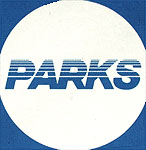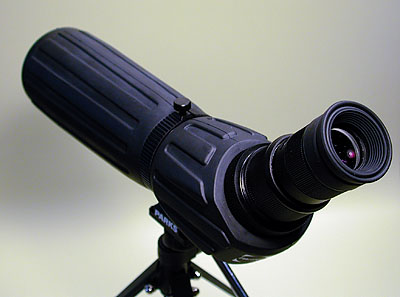AN AFFORDABLE SPOTTING SCOPE
Malibu Scope --
Beyond the Long Zoom
 By MIKE PASINI
By MIKE PASINIEditor
The Imaging Resource Digital Photography Newsletter
Review Date: February 2005
Any minute now the doorbell is going to ring. And standing there with a fresh coat of jet lag will be the Rapp family. Mom and Dad and the three miniature Rapps: Sam (7), Oliver (5) and Vivian (3).
We will greet them with open arms, of course, hiding the handcuffs in our back pocket and confident that the smoke alarm batteries have all been recently renewed. But in a more avuncular moment, we thought of a way to show them what fun it is to see beyond the normal range of human vision.
A telescope came to mind, naturally. The rings of Saturn. The craters of the moon. But we wanted to exhaust them before the sun set, so that was out. Telescopes, anyway, are more trouble than children. Alignment, tracking, all that nonsense. And even then, the image is upside down and reversed. What kid has patience for that?
THE SCOPE MAN | Back to Contents
We deferred to an expert. "Expert," we explained, "we have this picture window with a view of the ocean several miles away. What do you recommend for spying?" He knew immediately what to recommend. A spotting scope.
Somewhere between the 10x magnification of a long zoom and a 60x entry-level telescope is the spotting scope. Designed for terrestrial viewing, it behaves more like a long zoom than a telescope, displaying the image in the right orientation. And because you can mount a camera (film or digital) to it, it makes a tempting accessory.
 |
| The Malibu Scope |
 |
| Bird's Eye View |
Or would if it didn't cost more than your camera (which, according to our formula, makes the camera the accessory of the scope). But recently, we came across an affordable model from Parks Optical (http://www.parksoptical.com) in Simi Valley, Calif. Parks makes telescopes and camera adapters, too.
The $250 Malibu scope includes a carrying case (because it's small enough to go with you, like a large zucchini), tabletop tripod and a camera adapter. The weatherized scope with multi-coated elements to reduce glare has two controls: a zoom ring that travels from 12-36x 50mm magnification and a focus ring.
| Lumicon |
MOUNTING A CAMERA | Back to Contents
You don't need a digicam to appreciate the Malibu. Mount it on a tripod and scan the horizon and you'll see things that would otherwise cost bus fare. But you won't do that longer than it takes four NiMH AAs to recharge before you wonder just how much trouble it would be to affix your digicam instead of your eyeball to the Malibu.
Fortunately, Parks is a step ahead of you.
The Lumicon Universal Digi-Cam Adapater made by Parks is a tortured piece of engineering that makes it possible to mount and align many digicams to some foreign optical assembly like a telescope. Parks claims the aluminum alloy adapter fits eyepieces 28-45mm in diameter. It mounts (and can be mounted) via a standard 1/4x20 tripod mount thread.
 |
| Camera Adapter |
The scope (telescope or spotting) has to have a cylindrical eyepiece on which to clamp the adapter. The adapter itself provides two threaded slots on its camera platform, one aligned with the lens and the other offset. It takes just a slight turn of one or another worm-drive screw to align the mounted camera to the foreign optics.
If you want to mount a dSLR, though, you can dispense with the Lumicon. The Malibu scope includes a camera adapter ingeniously designed with cutouts to allow zooming and focusing the scope with the adapter attached. An inexpensive mounting ring for your camera is all that's needed to attach your dSLR to the Malibu.
In short, you have no excuse not to mount your digicam to the Malibu. And it's half the fun, anyway.
FRAMING THE SHOT | Back to Contents
While it may seem daunting, it's remarkably simple to frame a digicam shot with the spotting scope.
First you mount the scope to a sturdy tripod (no hand-holding these babies) and scan your scene. The scope has a cradle to lock the angle of the scope's eyepiece, so it can be rotated while mounted on the tripod. But mostly, you'll zoom to wide-angle (if you can call 12x zoom wide-angle) and focus to scan your scene for a shot. You can then zoom in tighter and refocus -- before or after you mount the camera in the adapter.
Assuming the scope is in focus, you merely have to let the digicam focus through the scope (at infinity). You also have to zoom in close enough to avoid any vignetting. But then, you've got your shot.
There are some compromises to be paid here. Depending on your camera, you may have some vignetting if you zoom the Malibu to 36x magnification. But by adjusting the position of the digicam relative to the Malibu and zooming both a bit, you'll get full screen magnification superior to any long zoom.
SUITABLE SCENES | Back to Contents
With a terrestrial spotting scope, atmospheric conditions play a critical role in the quality of the image. A nicely illuminated early morning view can become hazy by noon when heat radiation makes it a moving image.
 |
| Our First Shot Our general vantage point (l) and the Malibu's point of view (r) |
But we were able to get clear terrestrial images at a distance of three miles before the earth started radiating heat. And seascapes held up even longer since the ocean indulges in waves of a different sort.
Filtering to cut down the haze would seem like an excellent idea, but scene brightness will suffer. The Malibu doesn't provide filter threads but our 67mm filters manually held up in front of the scope did just what we expected them to do.
SHARING THE IMAGE | Back to Contents
We would have to have been already mummified in a wax museum to expect Sam, Oliver and Vivian to buy tickets and line up behind the Malibu for a look at a dog run three miles away. Immediacy is the trick. Instantly shared by a wildly enthusiastic audience -- even if they are handcuffed.
Fortunately, you don't have to upload a bunch of images to Ofoto to share them immediately with the impatient. All you have to do -- assuming you've mounted your garden variety digicam to the Malibu -- is connect a video out cable from the camera to your television. If you've got one of those 42-inch plasma deals, you will actually bring the dog into your living room at full size. If all you have is a 13-inch black and white security CRT (like we do), you may have to bark ventroliquistically to carry it off. But your audience will see what the Malibu sees in real time.
And, with that VCR humming, you can tape the whole thing. Should you have the foresight to have loaded a blank tape.
Long zooms are miraculous but fussy. Without some sort of image stabilization, they might even be called cantankerous. But no one calls a telescope cantankerous because we all know them to be unwieldy (and backwards and reversed). The spotting scope demands nothing more elaborate than a tripod. And happily accommodates your digicam. And the Malibu is an affordable scope that has the miraculous advantage of managing to do what handcuffs only promise.